Yakushi-ji Temple, Nara
Built in the 7th century, Yakushi-ji was one of the Seven Great Temples of Nara and is head of the Hosso sect of Buddhism.
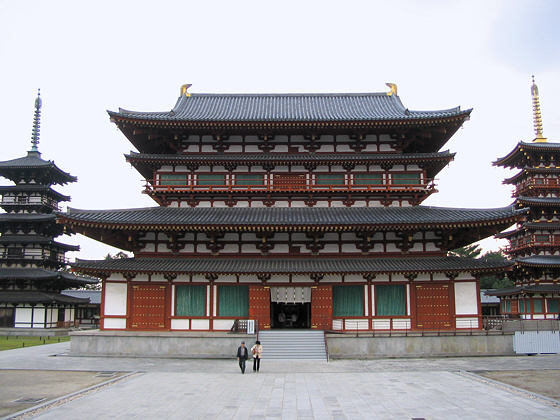
Main hall and pagodas at Yakushiji Temple.
The temple houses a fine collection of Buddhist art objects, including a Yakushi Triad, a Sho Kannon and an exquisite 8th century painting of Kichijoten (Kisshoten) on hemp cloth (shown only for a week in November).
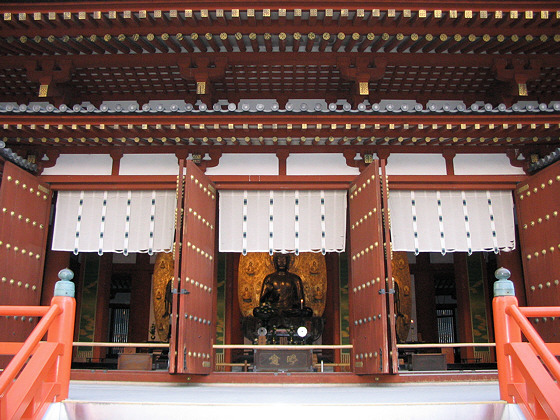
Yakushi triad at Yakushiji Temple.
Detailed information: Late in the 7th century (A.D.680), the construction of Yakushiji was planned by
Emperor Temmu to pray for the recovery of his Empress from a serious illness. The construction of
Yakushiji on the site of Asuka, the south part of Nara, in the Fujiwara Capital, was not completed
before the Emperor's death.
During the long term of the construction, Temmu died, and his Empress acceded to the throne and was
called Jito. In fact the actual construction was taken under her reign, and the dedication ceremony
for enshrining the chief Buddha, Yakushi Nyorai, was held in 697. The whole compound was completed in
698. But it was only ten years later that the Capital was moved to the north of Nara (in 710), and
Yakushiji was also moved to the present site in 718.
The splendid layout of buildings including Kondo (Main Hall), Kodo
(Lecture Hall), the East and West Pagodas seemed like the reappearance of
the paradise on the earth. However, Yakushiji was burnt down and destroyed
by fires, wars, or natural disasters several times, and the largest damage
was caused by the civil war in 1528. Today only the Yakushi Triad in the
Kondo, the Sho-Kannon in the Toindo, and the East Pagoda recall the
grandeur of its original features.
Yakushiji is one of the seven large temples in Nara (Todaiji, Daianji, Yakushiji, Saidaiji,
Gangoji, Horyuji, and Kofukuji), and the head temple of the Hosso Sect, the oldest Buddhist sect in
Japan.
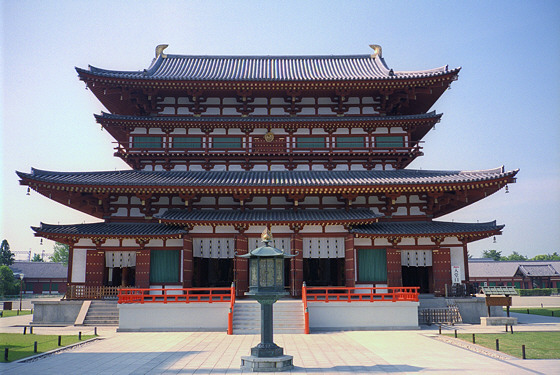
Main hall of Yakushiji Temple.
In 1976 the present Kondo (Main Hall) reappeared on the earth as if it were the Sea God's Palace as
the figure of the Hakuho Period instead of the temporary construction rebuilt in 1600. This hall was
erected through the movement for copying of the Heart Sutra. Millions of pious people took part in
this movement and made many donations to rebuild the Kondo.
The principal images in the Kondo, the Yakushi Triad, consist of Yakushi Nyorai and two attendant
Bodhisattvas. They were originally covered with gold, but the great fire of 1528 gave the statues
their present appearance of rich black sheen.
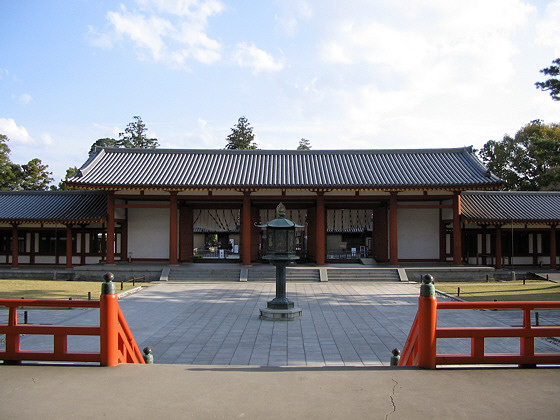
South gate of Yakushiji Temple.
Yakushi Nyorai (Buddha Bhaisajyaguru) is a National treasure from the Hakuho Period (645-710). It
is cast in bronze and 255cm high. The statue was originally cast by the order of Emperor Temmu in 680,
and completed by Empress Jito in 697.
He is the Buddha of Healing, and the Lord of the Emerald Pure Land in the East, who vowed to cure
disease of the mind and body. For this reason he was already very popular in Japan before the 7th
century. He is also worshiped in order to achieve longevity. Although Yakushi Nyorai generally has a
medicine pot in his left hand, the statue in this temple does not have it and he sits on the medicine
box instead of the lotus pedestal.
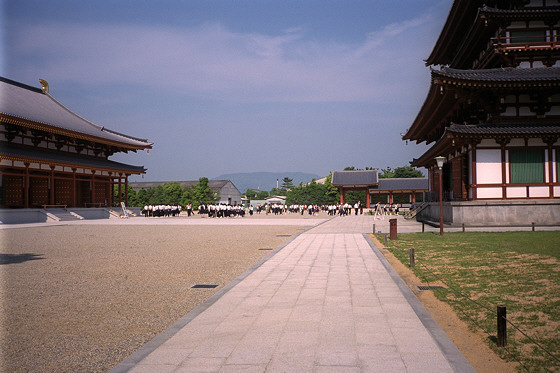
Mountains seen beyond the main halls of Yakushiji Temple.
The bronze Pedestal of Yakushi Nyorai is a National Treasure from the Hakuho Period. It's
height is 150cm.
The designs in relief on the pedestal are unique in their combination of various elements
with different cultures of the world. The grape-vine scroll pattern at the edge of the upper
projecting frame is very close in style to Greek work. The lotus flower pattern around the
pedestal is seen in Islamic mosques in the Middle East. The barbarians crouching in the
decorative arch are often seen at Hindu Temples in India. The strange animal designs of the
dragon (the east side), the phoenix (the south side), the tiger (the west side), and the
tortoise (the north side) are influenced by the Tang Dynasty (618-907) in China.
These various designs of the pedestal show the internationality of the Nara Period. This
pedestal seems to be a symbol of the Silk Road.

Yakushiji Temple's Lecture Hall.
The bronze figures of Nikko Bosatsu (Bodhisattva Suryaprabha) and Gakko Bosatsu (Bodhisattva Candraprabha) are National Treasures of the Hakuho Period, each 320cm high. Nikko Bosatsu attends Yakushi Nyorai on the right side, and Gakko Bosatsu attends him on the left side. Nikko means the sunlight and Gakko means the moonlight. They are impressive because of their twisted bodies, their graceful features, and the free flow of their robes. Yakushi Nyorai is similar to a doctor of mind and body. It may safely be said that Nikko and Gakko Bosatsu are the nurses.
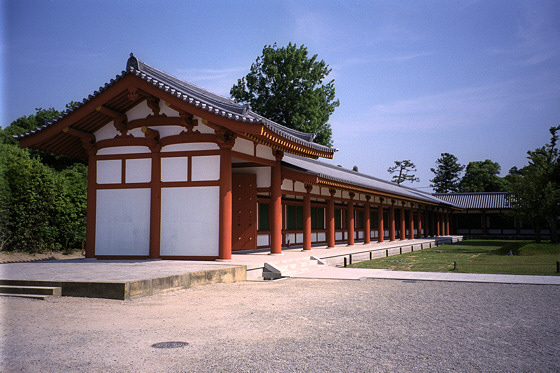
Yakushiji Temple's east wing.
The Kodo (Lecture Hall) was rebuilt in 1852. This hall enshrines another Yakushi-Triad (nationally important art object, Hakuho Period). On the eighth day of every month the Buddhist Service of Turning Sutras is held in this hall.
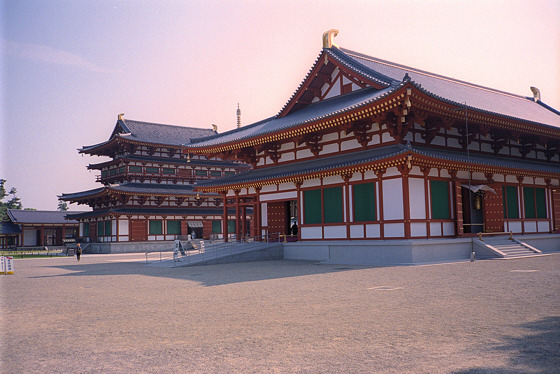
Yakushiji Temple's Main Hall and Lecture Hall.
"Pagoda" means a grave in Pali, the ancient Indian language, and it was called "stupa" in
Sanskrit. Pagoda is naturally different from a tower, for it is the grave of Buddha.
Yakushiji is the first temple which had the East and West Pagodas in its grounds.
The East Pagoda is a National Treasure from the Hakuho Period, 34 metres high. This pagoda,
miraculously surviving the fire that destroyed Yakushiji in 1528, is the only surviving
architecture of the Hakuho Period in Japan. This three-storied pagoda, which looks as if it
were six-storied because of the Mokoshi (lean-to) added to each story, is rare in its style,
and is described as "Frozen Music" because of its rhythmically fine appearance. The original
meaning or form of the grave of Buddha has been given to the Sorin part (metal roof-top
ornament).
The bronze Sorin is 10 metres high and weighs 3000kg. The Sorin, set above the uppermost roof
of the pagoda, is composed of Hoju, Ryusha, Suien, Kurin (nine rings), Fukubachi, and Roban.
The bronze Suien (Flamy splashing water) is 190cm high. The Suien, consisting of four pieces,
shows the fine openwork of twenty-four images of child musicians and angels scattering
flowers. As traditional Japaneses architectures are wooden, they are very dangerous in a time
of fire. They have an ornamental charm against fire, such as fabulous dolphins on the top of
the castle, fish tails on the roof of the Kondo, or Suien on the finial of the
pagoda.
Unfortunately the original West Pagoda burned down in 1528. After the reconstruction of the
Kondo, the West Pagoda was rebuilt in 1980 owing to the movement for the copying of the Heart
Sutra.
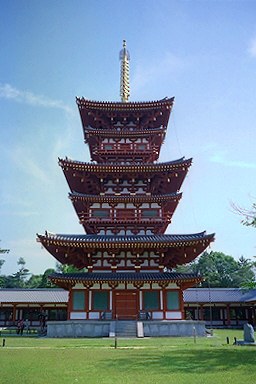
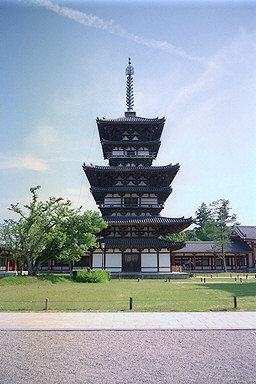
The reconstructed west pagoda and original 8th century east pagoda.
The Toindo is a National treasure, rebuilt in 1285. The original
construction had been erected in 721. The hall is the oldest Zen hall in
Japan. It enshrines a Sho Kannon (Bodhisattva, Aryavalokitesvara), which
is a National treasure from the Hakuho Period (645-710). The statue is
cast in bronze and 190cm high.
The Sacred Avalokitesvara (Kannon) is one of the six manifestations of
Kannon, who is chiefly believed to save hungry spirits. The statue retains
some influence of the Indian sculpture of the Gupta Period (350-650),
which came through China in the early Tang Dynasty (618-907), in the fine
modelling of the hair hanging over the shoulders, the double linked jewels
encircling the neck, the delicate gesture of the fingers, the thin
transparent drapery winding about the body, and the straight
posture.
This graceful figure and the nobleness in his youthfulness are
vividly described in the words, "Representation of sublimated prayers". A
folk-tale says that this statue was dedicated for the unfortunate life of
Prince Arima, who was a hero of tragedy in the Hayuho Period, and died at
the age of nineteen on the execution ground.
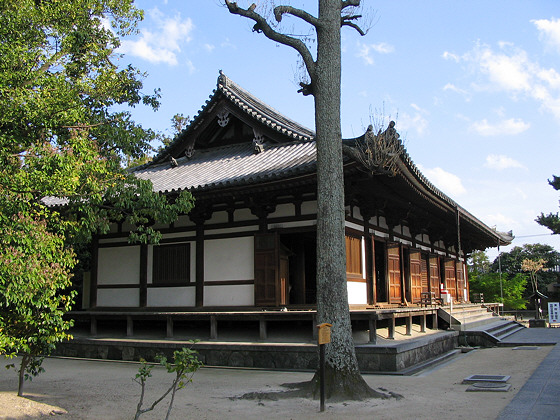
Toindo at Yakushiji Temple.
The beautiful painting of Kichijo-ten is a National Treasure from the Tempyo Period, and shown only from January 1-15 and October 8 to November 10. Kichijo-ten (Srimahadevi) is the Buddhist goddess of peace, happiness, and beauty. This is the oldest independent colored painting in Japan, and shows the realistic representation of lady's clothing in those days. It is not only a beautiful painting, but also a religious object. In January the Buddhist Confession Service is held in front of Kichijo-ten in the Kondo. It is said that the model of this Goddess was Empress Komyo.
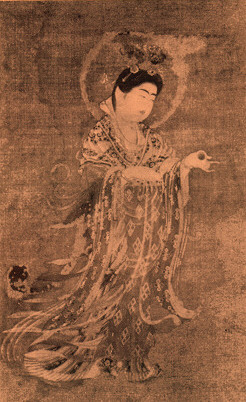
8th century painting of Kichijoten.
The Bussoku-seki and Bussoku-seki Verses Tablet are enshrined in the
Kondo, (Main Hall). The Bussoku-seki (Stone with the imprint of Buddha's
feet) is a National treasure from the Tempyo Period (710-784).
Bussoku-seki shows the older religious form of Buddhism before
ancient Greek civilization influenced the Indians for worshiping images
such as an image of Sakyamuni Buddha. It was deeply worshiped by ancient
people just as the Buddhist image is worshiped today. The shape of the
Buddha's foot is flat, and Horin (Circles of truth) are engraved on the
feet. The length of the feet is 47cm. This Bussoku-seki was made in
752.
The Bussoku-seki Verses Tablet is a National Treasure from the Tempyo
Period. This tablet is the oldest one in Japan, on which twenty-one verses
praising the Bussoku-seki are inscribed in the letters of the Tempyo
Period. These verses are composed in a special style, each of then
consisting of thirty-eight letters, were sung by the pious people through
the religious practice of worship. The verses are also very important in
Japanese literature.
The Hachiman Shrine is a nationally important art object, rebuilt in 1603.
It stands about 50 meters from the South Gate. There enshrined are wooden
sculptures of Hachiman as a priest (the principal god of the Hachiman
Shrine), Empress Jingu, and Empress Nakatsuhime. They are all National
Treasures.


